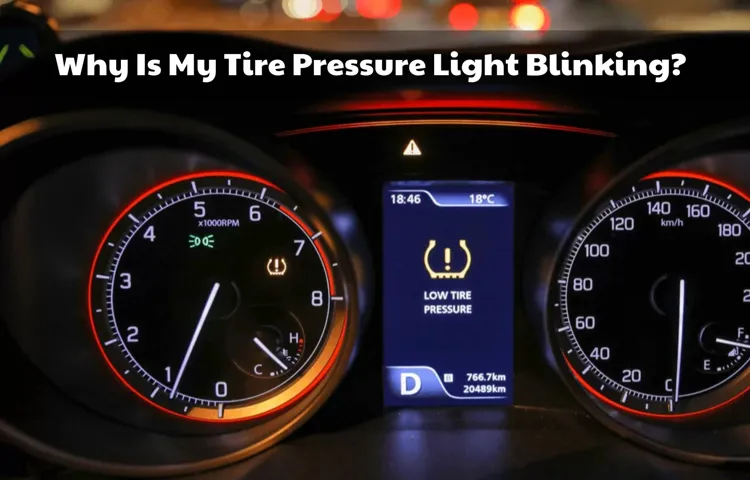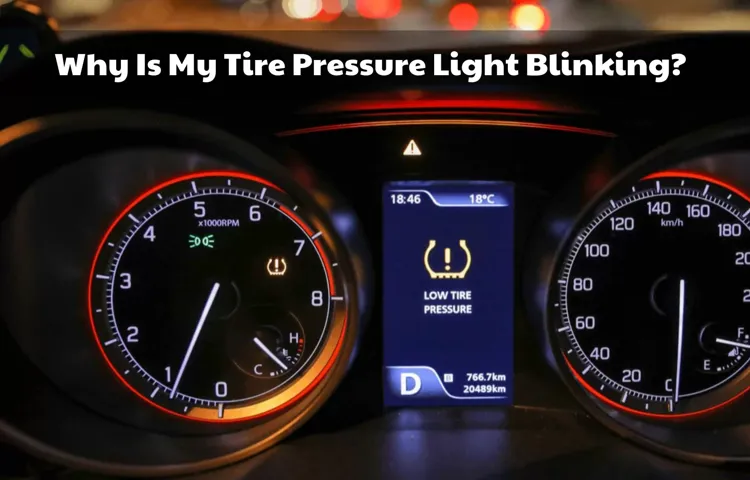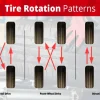Have you ever been driving along, minding your own business, when suddenly your tire pressure light starts flashing? It can be a bit jarring, especially if you don’t know what it means. But fear not, we’ve got you covered! In this blog post, we’re going to dive into what a flashing tire pressure light means and why it’s important to address it right away. Think of it as your quick and easy guide to understanding your car’s warning signals.
So buckle up and let’s get started!
Table of Contents
Introduction
Have you ever been driving and noticed that your tire pressure light is flashing? It can be alarming to see it, especially if you’re not sure what it means. Generally, a flashing tire pressure light means that the system has detected a problem with your tire pressure. This can be caused by a number of things, such as a puncture or leak in one of your tires.
It can also indicate a problem with the tire pressure monitoring system itself. It’s important to address the issue quickly, as driving on underinflated tires can cause damage to your car, reduce your fuel efficiency, and even lead to accidents. If your tire pressure light is flashing, make sure to check your tires and the tire pressure monitoring system as soon as possible.
Explanation of the Tire Pressure Monitoring System (TPMS)
Tire Pressure Monitoring System (TPMS) Have you ever wondered why your car’s dashboard has a warning light that resembles a flat tire with an exclamation mark inside it? That is the Tire Pressure Monitoring System (TPMS) indicator, which tells you if your tire pressure is low. TPMS is an automatic system that monitors the air pressure in your car’s tires and alerts you if the pressure is too low. The purpose of the TPMS is to ensure that your vehicle’s tires have the correct air pressure by measuring the air pressure inside the tires.
Correct tire pressure helps to improve gas mileage, prevent tire damage, and reduce the risk of accidents due to tire failure. The TPMS is a vital component that ensures your safety while driving, and it’s important to understand how it works to keep your vehicle’s tires in optimal condition.

Possible Reasons Why Your Tire Pressure Light is Flashing
If you have ever had your tire pressure light flash, you know how frustrating it can be. The warning light can pop up out of nowhere, leaving you wondering if your tires are safe to drive on or if there is a maintenance issue that needs to be resolved. A flashing tire pressure light means that there is something wrong with your tires and that they need to be checked immediately.
There are many possible reasons why this light may be flashing, from a simple low tire pressure issue to a more complex problem with the tire pressure monitoring system itself. Regardless of the cause, it is important to take the necessary steps to resolve the issue before driving on the road.
What to Do When Your Tire Pressure Light is Flashing
If you notice your tire pressure light flashing while driving, it typically means that there is an issue with your tires. Your car’s tire pressure monitoring system is designed to alert you when your tires are under or overinflated. If the light flashes repeatedly, it may indicate that there is a malfunction in the system itself.
To resolve the issue, first, ensure that all of your tires are properly inflated to the recommended PSI level for your specific make and model of car. If your tire pressure appears normal, then there may be a sensor issue in your car that requires a professional diagnosis. It’s important to address any tire pressure issues quickly, as driving on improperly inflated tires can impact your car’s fuel efficiency and lead to tire damage or failure.
Check Tire Pressure Immediately
When you’re driving and your tire pressure light starts flashing, it can be alarming. But don’t panic – there are steps you can take to address the issue. The first thing you should do is check your tire pressure immediately.
Low tire pressure can lead to decreased handling, poor fuel economy, and increased risk of a blowout or other tire-related issues. To check your tire pressure, you’ll need a tire pressure gauge, which you can purchase at any auto parts store or many gas stations. Simply remove the cap from your tire valve stem and press the gauge onto the stem.
The gauge will give you a reading of your tire pressure in PSI. If your tire pressure is lower than the manufacturer’s recommendation (which you can find in your owner’s manual or on the inside of the driver’s side door), you’ll need to add air to your tires. This can also be done at many gas stations or auto parts stores.
By addressing your tire pressure issue promptly, you can ensure that you stay safe on the road and avoid costly repairs down the line.
Inspect Tires and Valves for Damage
If your tire pressure light is flashing, it’s important to take action before it turns into a bigger problem. One of the first things to do is to inspect your tires and valves for any signs of damage. Check for any punctures, cuts, or bulges on the tires, and make sure there is no debris or foreign objects stuck in the tread.
Valves should also be checked for any cracks or leaks, as this can cause the tire pressure to drop rapidly. If you notice any damage or issues with your tires or valves, it’s best to take your vehicle in for a professional inspection and repair. Ignoring these issues can lead to further damage and potentially dangerous situations on the road.
So, don’t take the risk and make sure to check your tires and valves regularly for any damage or signs of wear and tear.
Inflate Tires to Recommended Pressure
If you’re driving and suddenly notice your tire pressure light is flashing, the first thing you should do is find a safe spot to pull over and check your tires. Sometimes, the simple act of checking and inflating your tires to the recommended pressure can solve the issue. Look for your car’s manual or a sticker on the driver’s side doorjamb for the recommended tire pressure, and use a tire pressure gauge to ensure all tires are inflated correctly.
Driving with low tire pressure can affect your fuel efficiency, tire wear, and safety while on the road. It’s always better to be safe than sorry when it comes to your tires and your car’s performance. Remember, a few minutes of quick maintenance can ultimately save you time, money, and hassle down the road.
So, don’t ignore that pesky tire pressure light and take action as soon as you can.
Reset the TPMS System
If you’ve ever been driving down the road and suddenly noticed your tire pressure light flashing on your dashboard, you know how nerve-wracking it can be. Luckily, there are steps you can take to quickly reset your TPMS system and get back on the road safely. Start by checking all your tire pressures with a gauge, and inflate them to the recommended PSI if necessary.
Then, find the TPMS reset button in your car (usually located in the glove box or near the steering column) and hold it down until you see the light start blinking. Finally, drive your car at a steady speed for 10-15 minutes, and the TPMS system should reset on its own. Remember to stay calm and take action as soon as you notice your tire pressure light flashing, as driving with low tire pressure can be extremely dangerous.
Preventing the Tire Pressure Light from Flashing
If you notice your tire pressure light flashing, it’s important to address the issue as soon as possible to avoid potential safety hazards. Typically, this means that your tire pressure is dangerously low and needs to be inflated immediately. It’s best to check your owner’s manual or the placard on the inside of your car door to determine the appropriate pressure for your tires.
It’s also a good idea to inspect your tires for any visible damage or punctures. To prevent the tire pressure light from flashing in the future, make sure to regularly check your tire pressure and inflate them as needed. This not only keeps you safe on the road, but also helps your tires last longer.
Don’t take the flashing tire pressure light as a nuisance, take it as a reminder to ensure your vehicle is in top shape and ready to hit the road.
Maintain Proper Tire Pressure and Inspect Tires Regularly
Maintaining proper tire pressure is a crucial aspect of vehicle safety that should never be overlooked. Driving with underinflated tires can lead to poor fuel efficiency, reduced handling, and potentially dangerous blowouts. That’s why it’s important to regularly inspect your tires and keep them at the manufacturer’s recommended pressure.
If you notice your tire pressure light flashing, it’s likely a sign that your tires are not properly inflated. But what causes this in the first place? Aging tires, punctures, and changes in temperature can all lead to changes in tire pressure. By performing regular checks and ensuring proper inflation, you can prevent the tire pressure warning from flashing and ultimately protect both yourself and your vehicle.
Don’t forget to pay attention to your tire tread as well – bald or worn-out tires can also pose a threat on the road. So, the next time you’re hitting the pavement, remember to take a few minutes to check your tire pressure and tread. It could make all the difference in your driving experience.
Replace Damaged Tires and Components
If the tire pressure light on your dashboard keeps flashing, it’s most likely because of low pressure in one or more of your tires. The first step to preventing this is to check your tire pressure regularly and keep it within the recommended range. But even with regular checks, there are instances where your tires and components suffer damage, causing your tire pressure to drop unexpectedly.
That’s why it’s important to replace damaged tires and components immediately to avoid further problems. Ignoring tire pressure issues can lead to a lack of traction, decreased gas mileage, and even the possibility of accidents. So, don’t take any chances and visit your trusted mechanic to get your tires checked and replaced if needed.
Remember that safe driving starts with a good tire maintenance routine, and being proactive is key to avoiding any unexpected breakdowns on the road.
Conclusion
When your tire pressure light is flashing, your car is basically telling you, ‘Hey, something’s not right down under!’ Just like how your body sends signals when something is off, your car has its own way of communicating. So when that pesky little light starts flashing, it’s time to pay attention and give your tires some TLC before hitting the road. Don’t let a flashing light deflate your driving experience!”
FAQs
Why is my tire pressure light flashing?
Your tire pressure light may be flashing as an indication that your tire pressure is low. It can also flash if there is an issue with the tire pressure monitoring system itself.
What should I do if my tire pressure light is flashing?
You should check your tire pressure as soon as possible. If the reading is low, inflate the tire to the recommended pressure level. If the light still persists, take your vehicle to a mechanic for further inspection.
Can the tire pressure light flash if all my tires are properly inflated?
Yes, it is possible for the tire pressure light to flash even if your tires are properly inflated. This could be due to a faulty sensor or electronic issue in the tire pressure monitoring system.
Is it safe to drive with the tire pressure light flashing?
It is not recommended to drive with the tire pressure light flashing as it can signal a serious issue that needs attention. Low tire pressure can result in decreased handling, stability, and can even lead to a blowout.
Will consistently low tire pressure cause my tire pressure light to flash?
Yes, if your tire pressure consistently stays low, it can cause the tire pressure light to flash. This is because low tire pressure can cause damage to the tire, which could result in a blowout.
Can extreme temperatures cause the tire pressure light to flash?
Yes, extreme temperatures can affect tire pressure. Cold temperatures can cause the air inside the tire to contract, resulting in lower tire pressure. This can cause the tire pressure light to flash.
Should I rely on the tire pressure monitoring system alone to maintain proper tire pressure?
No, it is recommended to manually check your tire pressure every month, even with a functioning tire pressure monitoring system. This will ensure that you catch any issues before they become serious and potentially dangerous.



